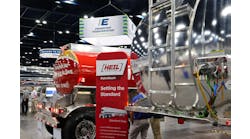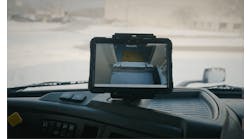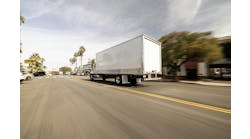Cargobull upgrades TRU performance, adds options
Schmitz Cargobull to raise prices 3-5%
Kwik Equipment marks 10 years
Stoughton launches PureBlue production - Details the key to new reefer design, manufacturing process
In less than 60 years, Stoughton Trailer has grown from a small truck body shop in southern Wisconsin to become the fifth largest trailer manufacturer in the United States—but something has been missing, or had been, at least until production began on the PureBlue refrigerated trailer at the company’s Evansville, Wis. manufacturing facility.
Simply, Stoughton needed a reefer to complete a full product offering, as Director of Engineering Todd Eicher explained to Trailer-Body Builders during an exclusive first look at the new production line in action.
“If we have the opportunity to serve our current customer base, or to attract new customers, and we can’t offer a refrigerated trailer, then we just lost a piece of the business to our competitors,” Eicher said. “We’re in it for the long haul.”
The PureBlue trailer was launched at the North American Commercial Vehicle Show in Atlanta last fall.
“This really does help give us that full lineup that we needed,” added Ron Jake, Stoughton marketing manager. “Having this product helps us complete the offering, add more value to our dealer network, and grow our customer base—it was a product gap that needed to be filled. The demand has been great. We have a very enthusiastic customer base trying to find a place in line.”
The genesis
Among the most impressive aspects of the new trailer and the production line is that PureBlue has gone from strategic initiative to rolling stock in less than three years. But product development is not new to Eicher.
After designing trailers for Fruehauf, Eicher joined Stoughton in 1993. In the ‘90s, the company initially produced a reefer through a joint venture with Stoughton Composites and Alcoa. While that model’s unique and advanced design was “a bit ahead of its time” and certainly had its fans (and still does, Eicher noted), a few customers found its unique design a challenge to repair. The line was discontinued in 1999.
Eicher emphasized that Stoughton has addressed “head on” any customer concerns about that earlier reefer. Based on lessons learned in the 1990s, the team chose to base the new product on a “conventional” design and to focus on engineering materials that provide the highest possible performance. “Starting in 2015, we examined the marketplace and evaluated design options for what has become PureBlue.”
The concept
A key part of the conceptualization process focused on how a Stoughton trailer product would distinguish itself in the market. The result: “We set ourselves apart with performance, that’s the difference,” Eicher said.
The design phase brought the concepts together, and the first prototypes were built at the Stoughton R&D facility, adjacent to Stoughton headquarters. The prototypes then underwent rigorous durability and floor rating testing, including on-track proving grounds, as well as thermal testing and validation with the major reefer unit manufacturers.
Conversion of the Evansville facility for PureBlue production began in March 2017, and the first pre-production unit rolled off the line in the first week of November.
With over 25 prototypes now in the field, 16 different customers have put PureBlue to work. “We’ve learned some things that we were able to fold into the design that improved both manufacturability and overall product quality,” Eicher said. “The thermal performance has really proven out over the testing we’ve done, and our customers [who received the prototypes] agree.”
The team also has made “a distinct effort” to take advantage, wherever possible, of product “commonality” with the Stoughton dry van product lines.
“If you set them side-by-side, they look like family—that was certainly the intention,” Eicher said. “We share a lot of common parts. That helps us with efficiencies of scale in our manufacturing operations. We do all of our materials fabrication in the same plant, both dry van and reefer. And it doesn’t just help us in manufacturing, it helps our customers reduce repair parts and inventory .”
And even where the components differ, they’ve worked to make sure both products are recognizably Stoughton trailers, he added.
As with the Stoughton dry vans, PureBlue comes standard (no additional cost or weight) with a rear underride guard built to resist compartmental intrusion on a car when impact is at 30% to 100% overlap.
The design
The PureBlue structure contains no wood, emphasized Eicher. Instead, the unique design calls for engineered composite floor insulators. The strength of the composite material provides weight reduction, and it’s very thermally efficient. Additionally, the engineered composite floor support is not subject to rot, so as the trailer ages, if moisture seeps in, the floor will not fail.
The floor system features 5.25-inch extruded-aluminum cross members in the bay area, with optional steel cross members.
For insulation, Stoughton opted to go with a platen foaming method to ensure thermal efficiency. In the process, each subassembly (sidewalls, front wall, doors, roof) is insulated before being put together into the box. Once assembled, all connections are separately foamed to ensure an airtight seal.
As Eicher illustrated (he’s quick to grab a marker in the conference room whiteboard), the platen method provides more consistent insulation, than other methods as well as smoother surfaces—meaning generally tighter quality control. Smoother walls are less susceptible to damage from scrapes—again, making for longer-lived product. To address the issue of fully sealing the box with insulation, the connections at the joints are foamed individually.
In addition, the fully enclosed floor design prohibits moisture from sidewall damage entering the floor insulation. An optional floor feature includes a knurled top surface for skid resistance, which improves driver safety and reduces cargo movement.
The side posts in the intermediate areas between the trailer 4-foot panel-to-panel connections are bonded to increase the thermal efficiency and to ensure a smoother wall surface.
“We’re giving the customer a much smoother trailer for graphic applications,” said Eicher, “but the bigger part of the equation leads to improved, long-term performance because we’ve removed over half of the sidewall rivets. And everywhere you put a rivet is an opportunity for water to find its way through.”
Rather than using steel or aluminum for the refrigeration unit mounting frame, the front wall is built using a low-conductivity composite material, which reduces weight and increases thermal efficiency.
“We’ve proven through our durability testing that the structure is more than up to the task for a 2-ton reefer unit,” Eicher said.
Similarly, the rear doors use the same high-strength composite material to provide the structure to optimize thermal efficiency and reduce weight.
Additionally, rather than a bolted-on compression gasket, the PureBlue rear door incorporates a triple wiper seal gasket that not only maintains its shape--minimizing air loss and protecting the interior—but if damaged , the snap-lock gasket is easily replaced without disassembling the entire door.
“It’s a very simple design, with very few parts: No fasteners, no holes to contend with,” Eicher said. “It’s a very simple door to repair.”
But the PureBlue design doesn’t call for composites just for the sake of composites. “We’re using a high-strength, engineered composite material where it makes the most sense. We’ve tried to preserve a conventional design for the customer, where their maintenance and repair staff will feel absolutely at home,” Eicher said. “Where we’ve integrated the composites is where it gives the customer the greatest advantage: the floor support structure, the rear doors, and the front wall.”
On the floor
The Stoughton Evansville facility, home to the company’s Diversified Trailer Product Division, has over 320,000 sq. ft. of manufacturing space under roof. Three different product lines (reefer, chassis and specialty dry van) each use about one-third of the space.
The PureBlue line occupies the part of the manufacturing floor that had been previously used by the container line.
“We’ve invested in what we feel is the best equipment possible to support this process,” Eicher said.
The “cornerstone” of the PureBlue production line is the Hennecke foam press, commonly referred to as “the big grilled-cheese maker.” The impressive unit, designed for insulating refrigerated trailers, is specifically set up and calibrated to serve the unique needs of PureBlue sidewalls.
The 270,000-pound large two-sided A-frame press has the capacity to process walls from 1-inch to 6-inch thick. The robotic mix head on the press has the ability to process panels in continuous pour mode to provide uniform foam density without foam dams; this means minimal thermal shorts through the thickness of the sidewall. The press can process one sidewall every 35 minutes through each side in continuous pour mode.
Temperature is controlled with multiple heaters and cooling units working in tandem to maintain ideal process temperature on the platen surfaces. The platens are positioned at 12 degrees off vertical for optimum foam processing. The structure of the press is built to withstand 530 tons of force from the foam expansion pressure.
The sidewalls are filled top down “to get consistent foam fill” with gravity providing a slight increase in foam density at the bottom of the sidewall, adding strength in an area most susceptible to damage.
More broadly, the sidewalls, floor, and roof are conveyed along parallel feeder lines, each with an appropriate foaming machine for the application. Overhead cranes carry the subassemblies laterally to the area where the box is assembled and the trailer then rolls in the opposite direction through the finishing and QA stations.
For a full-floor look at the PureBlue line, Eicher elevates a maintenance platform lift into the building’s rafters.
From the highly insulated sidewalls and composite rear door to a strong, durable floor, Stoughton left no stone unturned in designing a refrigerated trailer that is thermally efficient, lightweight, safe and long lasting.









